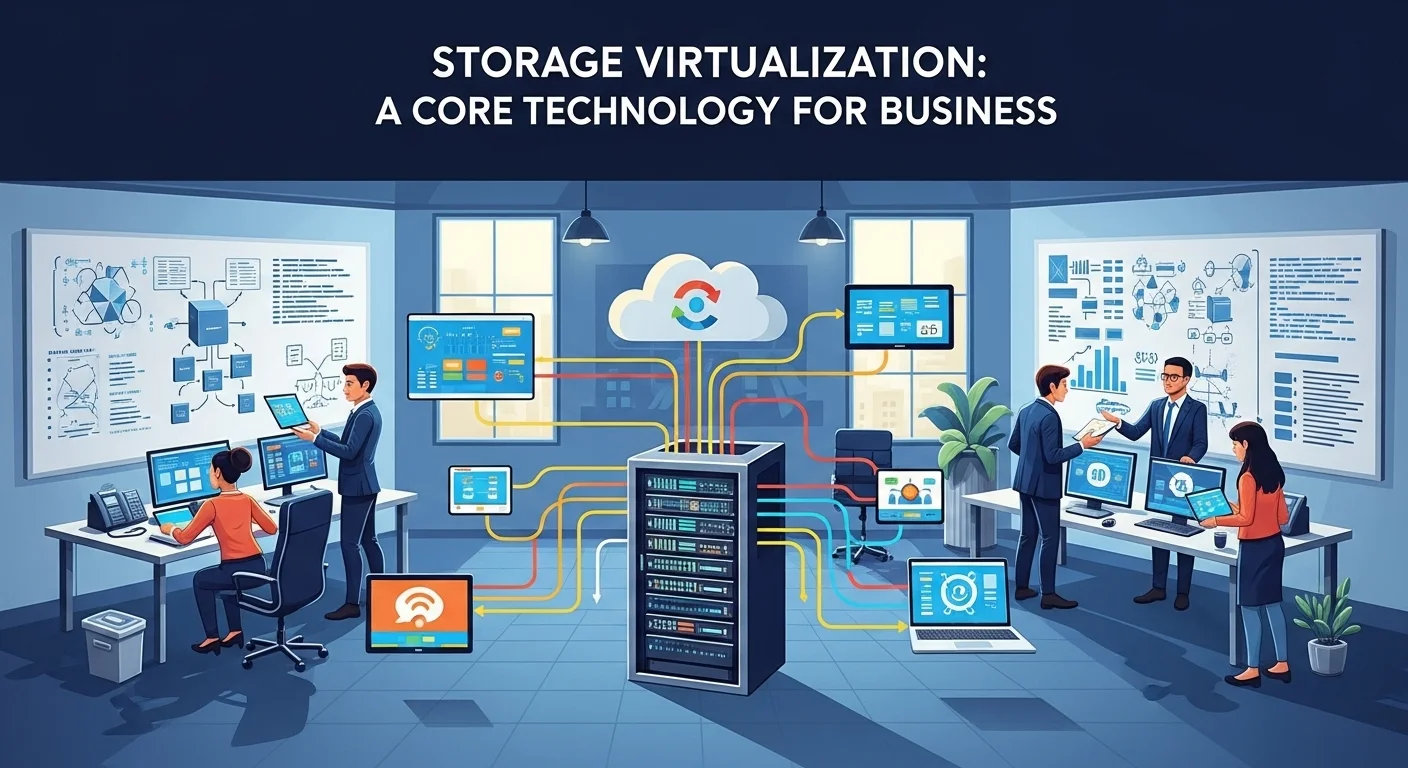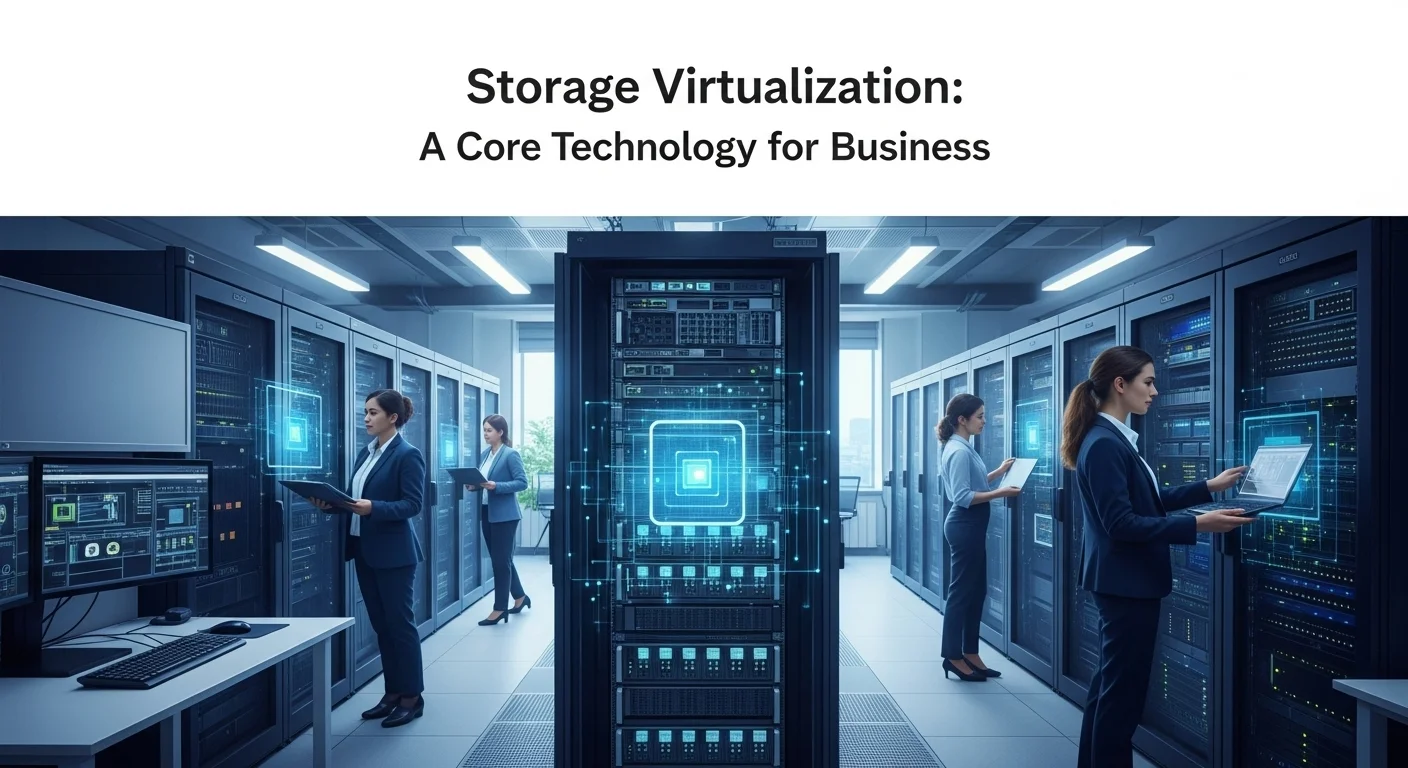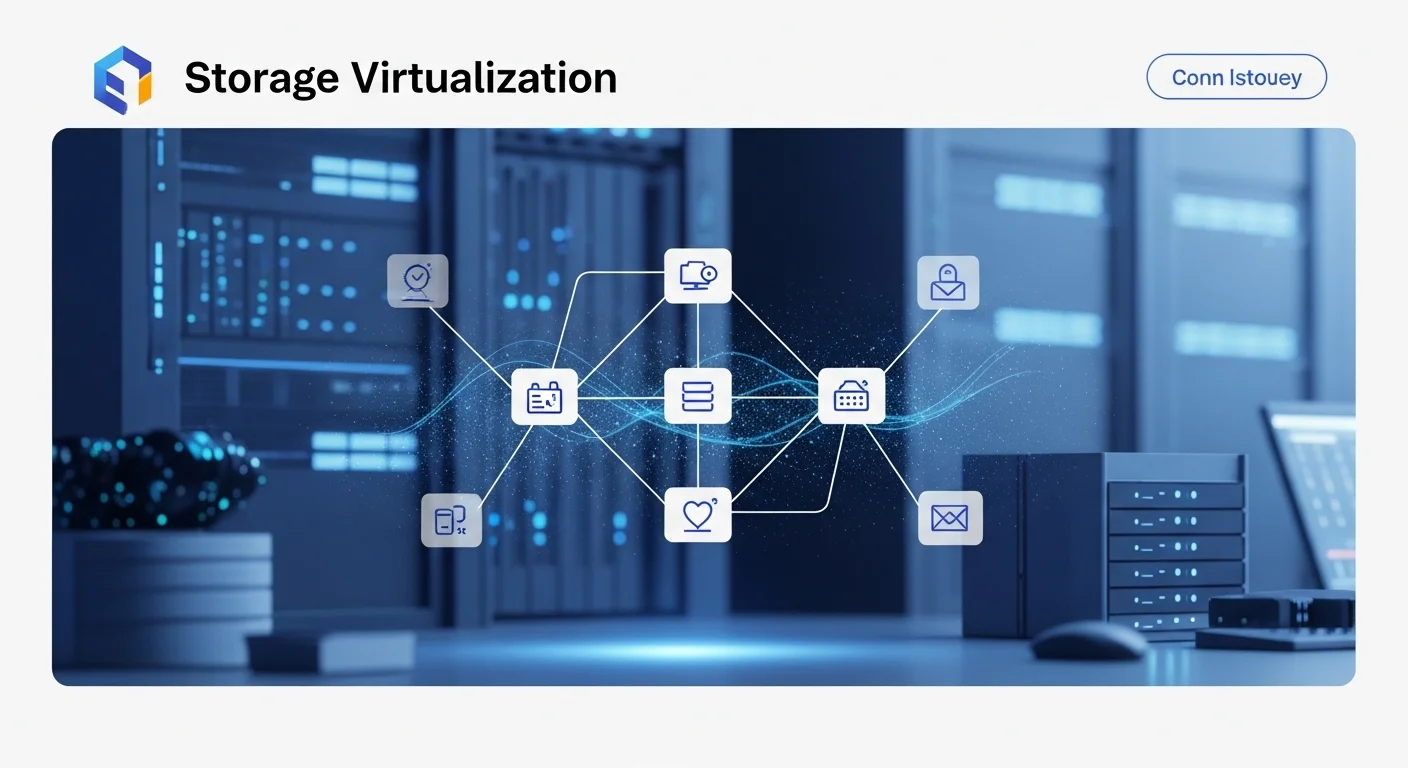Storage Virtualization: A Plain-English Guide for Your Business

Executive Summary
Storage Virtualization might sound like a complex buzzword, but it's one of the most transformative technologies I've seen in my career. At its heart, it's about taking all your different physical storage boxes—from various brands and of various ages—and pooling them into one single, easy-to-manage resource. Think of it as consolidating a messy garage full of separate toolboxes into one giant, perfectly organized cabinet where you can find any tool instantly. This abstraction of hardware is the secret sauce behind modern data centers and the cloud services we use every day. For any business, understanding this concept is key, as it leads to huge gains in efficiency, flexibility, and cost savings. It allows you to use every bit of storage you've paid for, simplifies critical tasks like backups, and gives you the agility to grow without constantly buying new hardware. This article is my comprehensive guide to help you grasp the concepts, benefits, and real-world applications of this essential technology.
Table of Contents
Table of Contents
- What is Storage Virtualization and Why Does It Matter?
- Why Technology Demands Virtualization
- The Essential Role of Virtualization in Cloud Computing
- Real-World Business Benefits
What is Storage Virtualization and Why Does It Matter?
In my years working in IT infrastructure, I've seen the term 'virtualization' change everything. We started with servers, then networks, and critically, storage. So, what is storage virtualization? It’s the magic of pooling all your separate physical storage devices into what looks and acts like a single, logical storage unit. A smart layer of software sits between your servers and your storage, acting as a translator. It hides all the complexity of your storage area network (SAN) or network-attached storage (NAS) systems. I like to compare it to a skilled librarian. Instead of you needing to know the exact aisle, shelf, and spot for every book, you just ask the librarian for what you need. That librarian—our virtualization software—manages a vast, consolidated collection and retrieves it for you. This central management console makes an administrator's life so much easier, allowing them to allocate, manage, and protect data with incredible efficiency. This technology is vital because it solves some of the oldest headaches in data management: isolated data silos, being locked into one hardware vendor, and paying for storage you can't even use. By creating one big, flexible pool, storage virtualization makes your entire data environment more efficient and resilient.
Why Technology Demands Virtualization
From a tech perspective, storage virtualization is a cornerstone of the modern, software-defined data center. It's about shifting focus from hardware to intelligent software, and the benefits are huge. First off, you get hardware independence. I've seen so many companies stuck with one vendor. Virtualization frees you from that lock-in. You can mix and match hardware from different manufacturers, choosing what's best for your budget and needs without worrying about compatibility. It even lets you breathe new life into older storage systems by adding them to the virtual pool for less critical tasks, like archiving, which is a great way to maximize your ROI. Secondly, it dramatically improves how you use your resources. In the old days, we always had 'stranded capacity'—pockets of unused disk space on different machines that were impossible to use elsewhere. Virtualization scoops up all that wasted space into one pool, so you can use every gigabyte. Features like thin provisioning, which allocates space only when it's actually needed, push that efficiency even further. Thirdly, it makes data management a breeze. Tasks like data migration used to be a nightmare—risky, complex, and causing downtime. In a virtualized world, moving data from an old system to a new one, or shifting it between fast and slow storage, happens seamlessly in the background without applications ever noticing. This agility is a game-changer for maintenance, upgrades, and balancing workloads. Plus, you can apply advanced data services like snapshots and replication across the entire pool, standardizing your data protection and making your whole infrastructure tougher.
The Essential Role of Virtualization in Cloud Computing
The rise of the cloud is completely tied to the power of virtualization. In fact, the way cloud computing uses storage virtualization is the fundamental reason providers like AWS, Azure, and Google Cloud can offer such massive, scalable, and flexible storage services. When you spin up storage in the cloud, you're not getting a piece of a specific physical drive. You're getting a logical slice from a gigantic, multi-tenant pool of virtualized resources. This is how cloud providers can offer virtual storage on demand. They abstract the incredible complexity of their global data centers and present you with simple options: block storage, object storage, or file storage. This entire model is built on the concept of data storage virtualization within the cloud. It ensures your data is logically separate and secure, even if it's physically on the same server hardware as another company's data. The virtualization layer handles all the mapping, security, and performance to meet the service agreements for every customer. Often, this is tightly integrated with computing power. It's common for cloud services to bundle virtual storage and servers together. For example, when you launch a virtual machine, it comes with its own virtual hard drive. This tight pairing of virtualized computing and storage is what allows businesses to deploy and scale applications in minutes—something unthinkable with traditional physical gear. The different types of virtualized storage in the cloud simply mirror the traditional models but are delivered 'as-a-service,' giving businesses of all sizes access to powerful, enterprise-grade tools without the massive upfront cost.
Real-World Business Benefits
The strategic impact of storage virtualization goes way beyond the IT team; it affects the entire business. The most immediate benefit is cost savings. By using your storage more efficiently and needing less new hardware, you lower your capital spending (CapEx). By simplifying administration, you reduce the operational costs (OpEx) of managing everything. That's money you can put back into growing the business. Another huge win is business agility. In today's market, you have to move fast. Virtualization gives you the flexibility to set up new applications or scale existing ones in a fraction of the time it would take with physical hardware. This means getting new products and services to market much faster. Perhaps the most critical advantage, in my opinion, is improved business continuity and disaster recovery. Virtualization makes replicating data to a backup site incredibly simple. And because the hardware is abstracted, your recovery site doesn't need to have the exact same expensive gear as your primary site, which can be a massive cost saver. The ability to automatically failover to a secondary site ensures your business can weather a major outage, minimizing downtime and protecting revenue. In short, storage virtualization isn't just a consolidation tool. It’s a strategic technology that creates a more agile, resilient, and cost-effective foundation for your business. It's the invisible engine powering the modern data-driven world.

A Complete Guide to Storage Virtualization Solutions
Diving deeper, storage virtualization isn't just one thing; it's an ecosystem of different technologies and approaches. As someone who has designed and deployed these systems, I can tell you that understanding the technical details is crucial for building a solution that truly serves your business. This guide will walk you through the methods, architectures, and strategies to help you make smart decisions.
Technical Methods: How Storage Virtualization Actually Works
At its core, storage virtualization works through a 'virtualization layer' or engine. This is a piece of software or firmware that sits between your servers and your physical storage. Its main job is to intercept all the data requests (I/O) from the servers and intelligently direct them to the right physical spot on your storage arrays. This process involves three key steps: pooling, abstraction, and mapping. Pooling: First, it gathers all the physical storage capacity from your different, mix-and-match systems into one big, unified resource pool. This breaks down the walls between individual devices. Abstraction: Next, the virtualization engine presents this giant pool to your servers as simple logical volumes. To the server's operating system, these virtual volumes look just like regular hard drives, even though they aren't tied to any single physical disk. The server has no idea about the complex reality underneath. Mapping: This is where the real intelligence lies. The engine keeps a detailed map that tracks where every logical piece of data actually lives on the physical disks. When a server writes data, the engine checks its map, decides the best physical place for that data based on performance or protection policies, and puts it there. This dynamic mapping is what makes cool features like seamless data migration and automated tiering possible.
Architectural Approaches: Host, Array, and Network-Based
There are three main ways to implement storage virtualization. I've worked with all of them, and the right choice really depends on your current setup, performance needs, and budget. These models are also the foundation for the different types of virtualized storage in the cloud.
1. Host-Based Virtualization
In this approach, the virtualization software runs right on your servers. It can be part of the operating system, or, more commonly, built into the hypervisor (like VMware's vSAN). It's the core idea behind hyper-converged infrastructure (HCI). When to use it: This is often your best bet if you're heavily invested in a virtual server environment and want a simple, all-in-one solution. It's cost-effective because you don't need extra hardware. The catch: It uses some of your server's CPU and memory, which could otherwise be used for your applications. Management can also be spread out across different hosts or clusters.
2. Array-Based Virtualization
Here, the virtualization smarts are built directly into a high-end storage array. This 'master' array then takes control of other, less-capable storage systems, pooling their capacity with its own. When to use it: This can deliver fantastic performance because the work is done by specialized hardware. It also gives you a single place to manage all the connected storage. The catch: The big risk here is vendor lock-in. You're tied to what that one vendor's system can do and what other storage it's compatible with. It also creates a potential single point of failure if that main controller goes down.
3. Network-Based Virtualization
This is my personal favorite for large, complex enterprise environments because of its flexibility. You place a dedicated virtualization appliance (like an IBM SAN Volume Controller) or a smart switch on your network, between the servers and the storage. This appliance intercepts all the storage traffic and works its magic there. When to use it: This is the ultimate choice for heterogeneity. It's completely independent and can virtualize storage from just about any vendor, giving you maximum freedom. Management is fully centralized. The catch: It does add another component to your data path, though these are always deployed in redundant pairs to prevent failure. There can also be a small amount of latency, and the initial cost of the appliance can be higher.
Business Solutions and the Cloud Connection
These architectures are the blueprints for powerful business solutions. For instance, data storage virtualization in the cloud is typically a massive, custom-built version of the host-based or network-based models. When you ask a cloud provider for a new disk, their control software talks to this huge virtualization layer, which carves out a logical piece for you. This is exactly how cloud services offer virtual storage in a flexible, pay-as-you-go model. The cloud's famous elasticity is a direct result of this. The fact that cloud services bundle virtual storage and servers together is a huge business enabler. It allows companies to launch entire application environments in minutes. On-premise, this is mirrored by HCI solutions, which use host-based virtualization to combine computing, storage, and networking in one easy-to-manage box. Choosing between them is a matter of trade-offs. An on-premise solution offers you maximum control but requires a big investment. Using storage virtualization in the cloud gives you incredible flexibility with no hardware to manage, but you might trade some control over performance. For many, a hybrid strategy is the sweet spot: keep your most critical workloads on-premise and use the cloud for things like disaster recovery and bursting capacity. Understanding these options is key, whether you're building a private cloud or just using a public one.

Tips and Strategies to Master Storage Virtualization
From my experience, just buying the technology isn't enough. To truly succeed with storage virtualization, you need a solid plan and a forward-looking strategy. Whether you're building it yourself or using the cloud, these are the tips and best practices I've learned over the years to help you get the most out of your investment.
Best Practices for Implementation and Management
A successful project starts long before you plug anything in. It begins with a smart strategy.
1. Start with a Thorough Assessment
Before you do anything, you need to know what you have. I've seen projects fail because they skipped this step. Use monitoring tools to get real data on your current storage capacity, performance (like IOPS and latency), and which applications are the most demanding. This data is gold. It will help you size your new solution correctly and decide on the right mix of fast and slow storage. And please, don't just plan for today. Forecast your growth for the next couple of years to make sure you're not painting yourself into a corner.
2. Choose the Right Architecture and Partner
Based on your assessment, pick the architecture—host, array, or network-based—that fits your environment. If you're a big VMware shop, an HCI solution might be a no-brainer. If you have a zoo of different storage brands, a network-based appliance offers the most freedom. When picking a vendor, don't just look at a feature checklist. I always consider their support quality, their partner ecosystem, and their vision for the future. The last thing you want is to be stuck with a proprietary solution that limits your options down the road.
3. Migrate in Phases, Not All at Once
Don't try to do a 'big bang' migration over a single weekend. It's too risky. I always recommend starting with less critical applications. This lets you get comfortable with the new platform and build confidence. Once you're live, set up clear policies for where your data should live. Use automated storage tiering to keep your most active data on your fastest, most expensive storage (like NVMe SSDs), while automatically moving older data to cheaper, high-capacity disks. This is the key to optimizing both performance and cost.
4. Be Proactive with Monitoring and Optimization
Your job isn't done after implementation. You have to continuously monitor the health and performance of your virtualized environment. Set up alerts for key metrics so you know about potential problems before your users do. Regularly look at performance reports to spot bottlenecks. From what I've seen, this proactive approach is what separates a smooth-running environment from one that's constantly on fire. Use these insights to tweak your policies and plan for future growth.
Leveraging Storage Virtualization in a Cloud Context
The principles we've discussed are the bedrock of cloud computing. To make the most of it, you need to understand how providers use storage virtualization in the cloud to deliver their services. They've made massive investments in data storage virtualization to create their offerings. Your job is to match your needs to their services correctly. For a high-transaction database, you'd pick a high-performance block storage service. For backups, you'd choose a low-cost object storage tier. This is how you practically apply your understanding of the different types of virtualized storage in the cloud. Many businesses I work with are landing on a hybrid cloud model. A common strategy is to use an on-premise virtualization platform for day-to-day work and replicate data to the cloud for disaster recovery. This works beautifully because cloud services offer virtual storage that is perfect for a DR target—it's affordable, scalable, and physically separate. And because cloud providers bundle virtual storage and servers, you can spin up an entire recovery site on-demand when you need it.
Security and Future-Proofing Your Strategy
Never treat security as an afterthought. A lesson I learned the hard way is that a centralized system can also be a centralized target. Implement multi-layered security. Encrypt your data both when it's sitting on the disks (at-rest) and when it's moving across the network (in-transit). Use strict, role-based access control (RBAC) to ensure people can only touch the resources they absolutely need to. And regularly audit your access logs to spot anything unusual. Finally, always keep an eye on the future. The tech world moves fast. Software-Defined Storage (SDS) and Hyper-Converged Infrastructure (HCI) are maturing and offering more automation. New tech like NVMe over Fabrics (NVMe-oF) is set to slash network latency. By committing to continuous learning, you can ensure your storage infrastructure remains a powerful asset that drives your business forward, rather than holding it back.
Expert Reviews & Testimonials
Sarah Johnson, Business Owner ⭐⭐⭐⭐
This was really helpful. I was struggling with managing our growing data, and this article explained storage virtualization in a way I could actually understand. I wish there were a few more small business examples, but it's a great start!
Mike Chen, IT Consultant ⭐⭐⭐⭐
A solid overview. As an IT pro, I appreciated the breakdown of host, array, and network-based architectures. It helped clarify which approach might be best for my different clients. Good, practical advice.
Emma Davis, Tech Expert ⭐⭐⭐⭐⭐
Excellent article! This is one of the clearest and most comprehensive pieces I've read on storage virtualization. It covers the 'what,' the 'how,' and the 'why' perfectly. The personal insights from the author made it much more engaging than a typical textbook explanation. Highly recommended!



